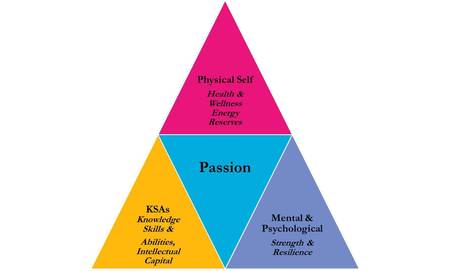Two years ago, I had a lengthy and disturbing conversation with a female friend of mine. By way of background, she is a successful global leader in her mid-forties who has travelled and worked internationally for two decades, made incredible contributions in the public and private sectors and has won numerous awards and accolades for her service and pioneering approach on a variety of global issues. To all of us who know her, she is a force of nature. We've marveled at her perseverance, determination and seemingly endless reservoirs of energy. She was also someone who on the outside seemed to take care of herself -- exercise, eat right, etc. -- so she could hop time zones and be sharp while balancing numerous crises on the fly. She took challenges head-on and kept moving up to increasingly higher profile posts. Then one day, she called me and said, "I'm done." She was hiding out in her family's cabin on the coast. "I am physically and mentally exhausted. My brain is fried and I have this weight behind my eyes... it literally aches and I can't get rid of it. = I'm burned out, have no idea what my next step is and I just feel done. =Now what?"
Burning the Candle at Both Ends
This call struck me as I was in the middle of developing a Women's Leadership course for the Hult International Business School in Dubai and because I too had experienced some of what she was experiencing, particularly after 9/11, when I was working at the U.S. Department of State and logging 12+ hour days of non-stop crisis response... the weight behind your eyes, the mental fatigue that won't go away and the feeling that even though you've been driven and accomplished much on paper, it's as if your body and your mind are grinding out each day and every task. The scary thing was that I was starting to see more and more of my colleagues at every age hitting this same wall seemingly earlier and earlier in their careers, especially those who pursued global careers. This cannot be healthy, there has to be a way to strengthen our minds and bodies to support our ambitions and 24/7 lifestyles.
So, what do you do when you hit a wall, mentally and physically, where do you go from there?
And more importantly, if you haven't hit the wall yet, how can you prevent burnout?
This question spurred me to embark on a two-year research project digging into anything and everything I could find about how to realistically build mental and physical resiliency while uncovering one's passion and purpose. As the pieces for my Women's Leadership course began to take shape, some of the inspiration for how we might reconsider our approach to leadership and charting our careers came with exploring McKinsey's groundbreaking research effort studying women leaders and subsequent book How Remarkable Women Lead: The Breakthrough Model for Work and Life by Joanna Barsh with Susie Cranston. After profiling dozens and dozens of successful female leaders they found adaptability, a flexible mindset and active reframing as keys to developing psychological resilience that is essential for personal growth and nourishing a successful leadership path. Further clues emerged when I focused much of my own research efforts and work examining global leaders, men and women, distilling down the characteristics that allowed for their continued and sustained success over a period of several decades. These leaders, like those McKinsey profiled, were not one-time leaders. Rather, I honed in on serial leaders who took on one global challenge after another and somehow managed to maintain a balanced personal life, their own health and mental stamina. I noted that each, while charting very different career paths, had four personal elements in common, essential elements that not only made all the difference in their leadership styles but also in their overall satisfaction with life and their place in the world.
First and foremost, they were all truly passionate about their work and being in a global environment. They genuinely enjoyed working across cultures and the unique demands, challenges and opportunities that such an environment presents. Passion, regardless of what you do, is an essential common thread that fuels successful, long-term leadership and personal growth. You can't fake passion. You either have it, or you don't... and if you haven't found it, it's never too late.
The Core Four: Essential Personal Elements of Leadership
In addition to passion, there are three other areas that each of the global leaders possessed and built strength in to varying degrees over the course of their careers:
- KSAs -- Knowledge, Skills, & Abilities -- Lifelong learners in many areas and disciplines
- Physical Self - Physical health, wellness, & shoring up energy reserves
- Mental & Psychological Strength, Resilience - Leverage a combination of strategies and focused attention on hone the brain's ability to respond to stress, crises and over stimulation
- Passion - Consistent pursuit of several efforts they are personally passionate about
Taking Stock - Which Areas of the Core Four do you Have Strength?
As The Core Four emerged, I began threading these concepts throughout my Women's Leadership course as well as presenting to diverse global audiences when I would speak to groups of executives at various leadership seminars. In each group I engaged, I asked them to take a quick internal inventory and rank for themselves from 1 to 4 where their individual strength levels rested for each of the four elements. Not surprisingly, and irrespective of where I was in the world, the areas most commonly cited as lacking strength overall were Physical Self and Mental & Psychological.
Additionally, women more often than not cited Mental & Psychological Resilience as their most challenging area followed by Passion. Men were reluctant to cite weakness in any area, however, once they engaged in a dialogue about these issues, men cited Physical Self and Passion as their most challenging areas, principally because many felt that they either did not have time, and/or felt as though the other areas were more important.
Knowing where you need to build strength and resilience though is only the first step. The key really is in building strength and resilience in each of the four areas in balance, continually and throughout your lifetime. Over the course of my next several posts I will share practical resources and insights for each of the four elements that I've gleaned and used firsthand from not only the global leaders I've been working with and following but also from leading health and wellness practitioners from a variety of disciplines and cultures. I look forward to hearing your recommendations as well as I continue to build on this work to help others uncover their inner strength , passion and purpose so that they have the tools in hand to prevent burnout and pursue whatever leadership path they choose.
This post is part of a series produced by The Huffington Post in conjunction with our women's conference, "The Third Metric: Redefining Success Beyond Money & Power," which took place in New York on June 6, 2013. To read all of the posts in the series and learn more about the conference, click here. Join the conversation on Twitter #ThirdMetric.

